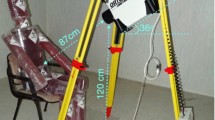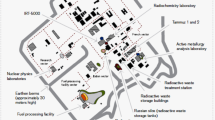Abstract
Dosimetry bioassay methods are the backbone of a personal dosimetry in criticality accidents. Although methods like hair dosimetry and the use of activation foils (e.g., 32S) have been employed for decades, capabilities of different techniques, effects of hair type and neutron spectrum on the dose response, sensitivity and uncertainties of different techniques, etc., need more investigations. For this reason, the use of the 32S(n,p)32P reaction and hair samples for estimating non-fatal doses from fast neutrons was studied. The experiments were carried out with the hair samples attached on a RANDO phantom in a Cf-252 neutron field, in the dose range of about 0.05–1.15 Gy. In addition, the adequate post-accident preparation for hair samples including optimum conditioning and timing were investigated. Experimental results prove the good sensitivity and merit of the method for neutron quantification in the mentioned dose range for which other bioassay methods are of poor resolution and sensitivity. A rough estimation of the dose–response curve for Iranian hair was also derived.



Similar content being viewed by others
References
Byoung-il K, Jeong-in K, Gyu-dong L, Young-khi L (2011) Neutron dose assessment using 24N in blood for Korean radiation workers. Nuclear Technol Radiat Prot 1:178–181
Clay RC, Cook K, Routh JI (1940) Studies in the composition of human hair. J Am Chem Soc 62:2709–2710
Feng Y, Brown KS, Casson WH, Mei GT, Miller LF, Thein M (1993) Determination of neutron dose from criticality accidents with bioassays for sodium-24 in blood and phosphorous-32 in hair. Oak Ridge National Laboratory, ORNL/TM-12028, National Technical Information Service, Springfield, VA
Franbourg A, Hallegot P, Baltenneck F, Toutain C, Leroy F (2003) Current research on ethnic hair. J Am Acad Dermatol 48:S115–S119
Hawk P, Oser BL (1965) Hawk’s physiological chemistry, chapters 4, 5, and 6. McGraw-Hill, New York
Hiroshi T, Kiriko M, Masae Y, Yushikazu N, Yoshito W, Hee Sun K, Shoichi F, Noriko K, Fuyuki K, Hisamasa J, Toshiyasu H, Makoto A (2001) Bioassay for neutron-dose estimations of three patients in the JCO criticality accident in Tokai-mura by measuring β-ray emitters. J Radiat Res 42:S129–S135
IAEA (1970) Nuclear Accident Dosimetry Systems, International Atomic Energy Agency, Vienna
IAEA (1982) Dosimetry for criticality accidents: A Manual, technical report series 211, International Atomic Energy Agency, Vienna
IAEA (2001) The Criticality Accident in Sarov, International Atomic Energy Agency, Vienna
Lebaron-Jacobs L, Gaillard-Lecanu E, Briot F, Distinguin S, Boisson P, Exmelin L, Racine Y, Berard P, Flury-Herard A, Miele A, Fottorino R (2007) Hair dosimetry following neutron irradiation. Radiat Saf J 92(2):S98–S104
Mianji FA, Rastkhah N, Kardan MR, Mehdizadeh S, Babakhani A (2007) Analyzing an accident related to orphan sources including dose assessment. Radiat Prot Dosim 123(3):394–397
Mianji FA, Karimi Diba J, Kardan MR (2013) Internal dose assessment for environmental monitoring in NPP accidents. Nuclear Technol Radiat Prot 28(3):325–331
Neutron Monitoring for Radiological Protection (1985) Technical report series no. 252, International Atomic Energy Agency, Vienna
NISA (2011) Nuclear and Industrial Safety Agency Report of Japanese government to the IAEA ministerial conference on nuclear safety—The accident at TEPCO’s Fukushima Nuclear Power Stations. http://www.kantei.go.jp/foreign/kan/topics/201106/iaea_houkokusho_e.html
Ott K, Helmecke M, Luszik-Bhadra M, Martin M, Weber A (2013) Dead-time effects of neutron detectors due to pulsed radiation. Radiat Prot Dosim 155:125–140
Robbins CR (2012) Chemical and physical behavior of human hair. Springer, Berlin
Robbins CR, Kelly CH (1970) Amino acid composition of human hair. Text Res J 40:891–896
Sakai K (2011) Lessons learnt from Fukushima accident. In: IAEA regional meeting in occupational radiation protection in emergency exposure situations, Chiba, Japan
Sohrabi M, Ghasemi M, Amrollahi R, Khamooshi C, Parsouzi Z (2013) Assessment of environmental public exposure from a hypothetical nuclear accident for Unit-1 Bushehr nuclear power plant. Radiat Environ Biophys 52:235–244
Solimanian A, Ghafoori M (2010) Standard calibration of ionization chambers used in radiation therapy dosimetry and evaluation of uncertainties. Iran J Radiat Res 8(3):195–199
Suzuki T (2011) Occupational exposure in Fukushima accident. IAEA Regional meeting in occupational radiation protection in emergency exposure situations, Chiba
Tatsuzaki H (2011) Medical management of emergency workers. In: IAEA regional meeting in occupational radiation protection in emergency exposure situations, Chiba, Japan
The Sasakawa Peace Foundation (2012) The Fukushima nuclear accident and crisis management (Lessons for Japan–US Alliance Cooperation), The Sasakawa Peace Foundation
Tucker JD, Vadapalli M, Joiner MC, Ceppi M, Fenech M, Bonassi S (2013) Estimating the lowest detectable dose of ionizing radiation by the cytokinesis-block micronucleus assay. Radiat Res 180(3):284–291
Acknowledgments
This work was conducted at the Nuclear Science and Technology Research Institute with financial support from the Iran Nuclear Regulatory Authority. The authors would like to sincerely thank Ms. Jila Karimi Diba, Mr. Daryoosh Marzbani, Dr. Seyed Mehdi Hosseini Poya, Mr. Mohammad Reza Dashtipour, and Dr. Samaneh Baradaran for their technical support and laboratorial cooperation during the project. The authors also highly appreciate Dr. Mohhamad Reza Kardan and all anonymous referees for their valuable comments on this article.
Author information
Authors and Affiliations
Corresponding author
Rights and permissions
About this article
Cite this article
Mianji, F.A., Jafari, S., Zaryouni, S. et al. Hair 32P measurement for body dose mapping in non-fatal exposures to fast neutrons. Radiat Environ Biophys 54, 61–69 (2015). https://doi.org/10.1007/s00411-014-0579-9
Received:
Accepted:
Published:
Issue Date:
DOI: https://doi.org/10.1007/s00411-014-0579-9




